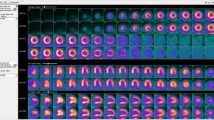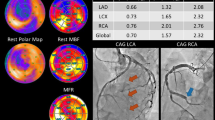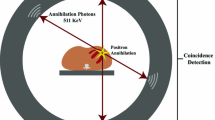Abstract
Despite being primarily a research tool, positron emission tomography (PET) has seen slow but steady growth in the clinical management of the cardiac patient. The two major clinical applications of cardiac PET are regional myocardial perfusion imaging to determine the presence and severity of coronary artery disease and metabolic imaging to differentiate viable from nonviable myocardium in patients with ischemic left ventricular dysfunction. Indeed, PET with either nitrogen 13 ammonia or rubidium 82 may offer advantages over current single photon emission computed tomography approaches to assess myocardial perfusion. PETwith fluorine 18 fluorodeoxyglucose is considered the current gold standard for identifying viable myocardium. Finally, the use of PET to quantify myocardial perfusion, metabolism, and innervation has led to key insights into the role of altered microvascular function, substrate metabolism, and neuronal function in a variety of cardiac disease processes.
Similar content being viewed by others
References and Recommended Reading
Baird MG, Bateman TM, Berman DS, et al.: ACC/AHA/ASNC guidelines for the clinical use of cardiac radionuclide imaging. J Am Coll Cardiol 2003, 42:1318–1333.
Hendel RC, Corbett JR, Cullom SJ, et al.: The value and practice of attenuation correction for myocardial perfusion SPECT imaging: a joint position statement from the American Society of Nuclear Cardiology and the Society of Nuclear Medicine. J Nucl Cardiol 2002, 9:135–143.
American Society of Nuclear Cardiology: Updated imaging guidelines for nuclear cardiology procedures. J Nucl Cardiol 2001, 8:G5-G58.
Bacharach SL, Bax JJ, Case J, et al.: ASNC practice guidelines: PET myocardial glucose metabolism and perfusion imaging; Part 1-guidelines for patient preparation and data acquisition. ASNC website. http://www.asnc.org/
Schelbert HR, Wisenberg G, Phelphs ME, et al.: Noninvasive assessment of coronary stenoses by myocardial imaging during pharmacologic coronary vasodilation. VI. Detection of coronary artery disease in human beings with intravenous N-13 ammonia and positron computed tomography. Am J Cardiol 1982, 49:1197–1206.
Gould KL, Goldstein RA, Mullani NA, et al.: Noninvasive assessment of coronary stenosis by myocardial perfusion imaging during pharmacologic coronary vasodilation. VIII. Clinical feasibility of positron cardiac imaging without a cyclotron using generator-produced rubidium-82. J Am Coll Cardiol 1986, 7:775–789.
Yonekura Y, Tamaki N, Senda M, et al.: Detection of coronary artery disease with N-13 ammonia and high-resolution positron-emission tomography. Am Heart J 1987, 113:645–654.
Tamaki N, Yonekura Y, Senda M, et al.: Value and limitation of stress thallium-201 single photon emission computed tomography: comparison with nitrogen-13 ammonia positron tomography. J Nucl Med 1988, 29:1181–1188.
Laubenbacher C, Stevenson L, Kobishagawa J, et al.: An automated analysis program for the evaluation of cardiac PET studies: initial results in the detection and localization of coronary artery disease using N-13 ammonia. J Nucl Med 1991, 34:968–978.
Sand NP, Bottcher M, Madsen MM, et al.: Evaluation of regional myocardial perfusion in patients with severe left ventricular dysfunction: comparison of N-13 ammonia PET and Tc-99m sestamibi SPECT. J Nucl Cardiol 1998, 5:4–13.
Grover-McKay M, Ratib O, Schwaiger MS, et al.: Detection of coronary artery disease with positron emission tomography and rubidium 82. Am Heart J 1992, 123:646.
Simone GL, Mullani NZ, Page DA, Anderson BA: Utilization statistics and diagnostic accuracy of nonhospital-based positron emission tomography center for the detection of coronary artery disease using rubidium-82. Am J Physiol Imaging 1992, 314:203–209.
Go RT, Marwick TH, MacIntyre WJ, et al.: A prospective comparison of rubidium-82 PET and thallium-201 SPECT myocardial perfusion imaging utilizing a single dipyridamole stress in the diagnosis of coronary artery disease. J Nucl Med 1990, 31:1899–1905.
Stewart RE, Schwaiger M, Molina E, et al.: Comparison of rubidium-82 positron emission tomography and thallium-201 SPECT imaging for detection of coronary artery disease. Am J Cardiol 1991, 67:1303–1310.
Marwick TH, Shan K, Patel S, et al.: Incremental value of rubidium-82 positron emission tomography for prognostic assessment of known or suspected coronary artery disease. Am J Cardiol 1997, 80:865–870.
Patterson RE, Eisner RL, Horowitz SF: Comparison of costeffectiveness and utility of exercise ECG, single photon emission computed tomography, and coronary angiography for diagnosis of coronary artery disease. Circulation 1995, 91:54–65.
Di Carli MF, Janisse J, Grunberger G, et al.: Role of chronic hyperglycemia in the pathogensis of coronary microvascular dysfunction in diabetes. J Am Coll Cardiol 2003, 41:1387–1393. Using quantitative measurements of myocardial perfusion demonstrated the central role of chronic hypoglycemia in microvascular dysfunction in patients with diabetes mellitus. Demonstrates the potential of quantitative PET MPI to characterize mechanisms responsible for microvascular dysfunction.
Tawakol A, Forgione MA, Stuehlinger M, et al.: Homocysteine impairs coronary microvascular dilator function in humans. J Am Coll Cardiol 2002, 40:1051–1058.
Pitkanen OP, Nuutila P, Raitakari OT, et al.: Coronary flow reserve in young men with familial combined hyperlipidemia. Circulation 1999, 99:1678–1684.
Cecchi F, Olivotto I, Gistri R, et al.: Coronary microvascular dysfunction and prognosis in hypertrophic cardiomyopathy. N Engl J Med 2003, 349:1027–1035. Demonstrated in patients with hypertrophic cardiomyopathy that abnormalities in myocardial microvascular function was an independent predictor of an adverse outcome. This study shows the potential of quantitative PET MPI to risk stratify patients.
Baller D, Notohamiprodjo G, Gleichmann U, et al.: Improvement in coronary flow reserve determined by positron emission tomography after 6 months of cholesterol-lowering therapy in patients with early stages of coronary atherosclerosis. Circulation 1999, 99:2871–2875. An intervention study that demonstrated the salutary effects of lipidlowering therapy on myocardial vasodilator function in patients with hyperlipidemia and early CAD. Demonstrates the potential of quantitative PET MPI to identify therapeutic strategies that may reverse cardiac disease.
Schelbert H, Beanlands RSB, Bengel F, et al.: ASNC practice guidelines: PET myocardial glucose metabolism and perfusion imaging; Part 2-guidelines for interpretation and reporting. ASNC website. http://www.asnc.org/
Conversano A, Walsh JF, Geltman EM, et al.: Delineation of myocardial stunning and hibernation by positron emission tomography in patients with advanced coronary artery disease. Am Heart J 1996, 131:440–450.
Bax JJ, Poldermans D, Elhendy A, et al.: Sensitivity, specificity, and predictive accuracies of various noninvasive techniques for detecting hibernating myocardium. Curr Probl Cardiol 2001, 26:141–186.
Rubin PJ, Lee DS, Davila-Roman VG, et al.: Differentiation of viable from nonviable myocardium by positron emission tomography in patients with recent myocardial infarction: superiority of C-11 acetate compared with F-18 fluorodeoxyglucose. Am J Cardiol 1996, 78:1230–1236.
Allman KC, Shaw LJ, Hachamovitch R, Udelson JE: Myocardial viability testing and impact of revascularization on prognosis in patients with coronary artery disease and left ventricular dysfunction: a meta-analysis. J Am Coll Cardiol 2002, 39:1151–1158. Demonstrated the importance of the presence of viable myocardium as a marker of adverse outcome unless coronary revascularization is performed.
Kates AM, Herrero P, Dence C, et al.: Impact of aging on substrate metabolism by the human heart. J Am Coll Cardiol 2003, 41:293–299. Demonstrated that aging is associated with a shift in myocardial substrate metabolism to a greater dependence on glucose use. The results show the potential of quantitative PET measurements to identify subtle changes in myocardial substrate metabolism.
De las Fuentes L, Herrero P, Peterson LR, et al.: Myocardial fatty acid metabolism: independent predictor of left ventricular mass in hypertension and in left ventricular dysfunction. Hypertension 2003, 41:82–87.
Davila-Roman VG, Vedala G, Herrero P, et al.: Altered fatty acid and glucose metabolism in idiopathic dilated cardiomyopathy. J Am Coll Cardiol 2002, 40:271–277.
Monti LD, Lucignani G, Landoni C, et al.: Myocardial glucose uptake evaluated by positron emission tomography and fluorodeoxyglucose during hyperglycemic clamp in IDDM patients. Role of free fatty acid and insulin levels. Diabetes 1995, 44:537–542.
Nowak B, Sinha AM, Schaefer WM, et al.: Cardiac resynchronization therapy homogenizes myocardial glucose metabolism and perfusion in dilated cardiomyopathy and left bundle branch block. J Am Coll Cardiol 2003, 41:1523–1528.
Stolen KQ, Kemppainen J, Ukkonen H, et al.: Exercise training improves biventricular oxidative metabolism and left ventricular efficiency in patients with dilated cardiomyopathy. J Am Coll Cardiol 2003, 41:460–467. Demonstrated that in patients with dilated cardiomyopathy, endurance exercise training decreases oxidative metabolism in both ventricles and improves the efficiency of the LV. The study shows how quantitative PET measurements of metabolism can be used measure the effects of a specific therapy.
Bengel FM, Uerberfuhr P, Hesse T, et al.: Clinical determinants of ventricular sympathetic reinnervation after orthotopic heart transplantation. Circulation 2002, 106:831–835.
Di Carli MF, Bianco-Battlles D, Landa ME, et al.: Effects of autonomic neuropathy on coronary blood flow in patients with diabetes mellitus. Circulation 1999, 100:813–819.
Mazzadi AN, Andre-Fouet X, Duisit J, et al.: Cardiac retention of carbon-11 HED in genotyped long QT patients: a potential amplifier role for the severity of the disease. Am J Physiol Heart Circ Physiol 2003, 2285:H1286-H1293. Demonstrated that in patients with mutations in the sodium and potassium channel genes and long QT syndrome heterogeneity in sympathetic innervation was increased. Beyond the mechanistic information, the study demonstrates the potential role of PET to characterize the phenotype of newly identified genetic disorders.
Author information
Authors and Affiliations
Rights and permissions
About this article
Cite this article
Gropler, R.J., Soto, P. Recent advances in cardiac positron emission tomography in the clinical management of the cardiac patient. Curr Cardiol Rep 6, 20–26 (2004). https://doi.org/10.1007/s11886-004-0061-4
Issue Date:
DOI: https://doi.org/10.1007/s11886-004-0061-4




